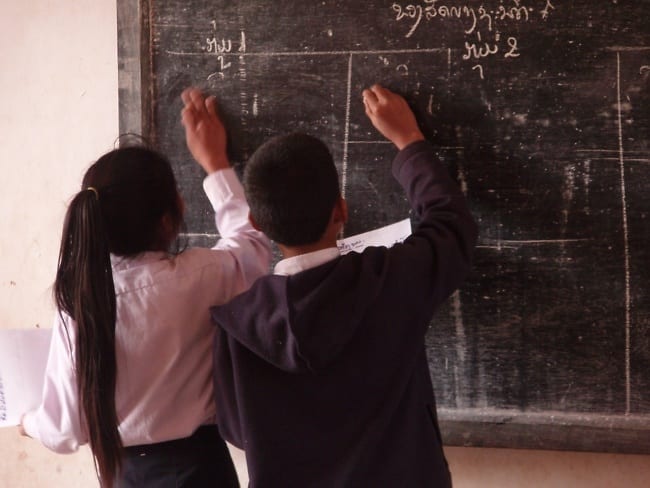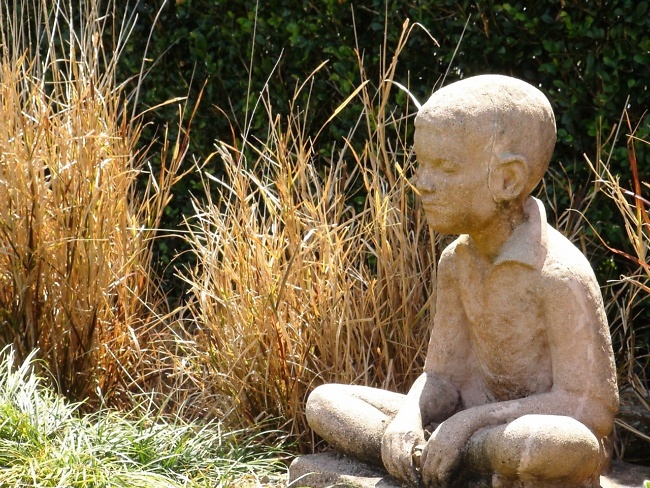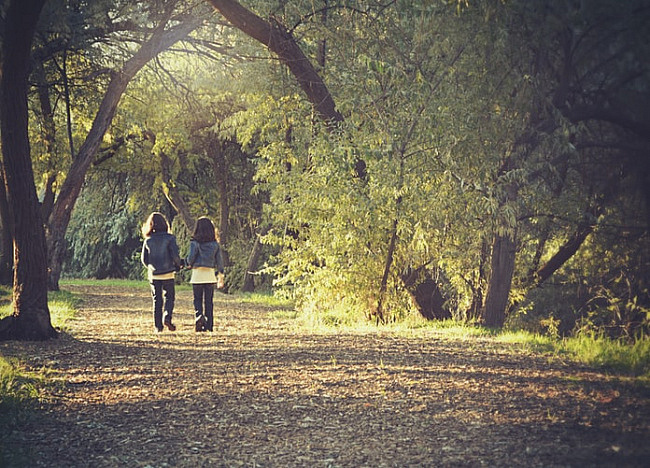Meditation can have a positive effect on the overall well-being of children. We live in an age of information that can easily overwhelm many adults—but for children, it can be far more stressful, because they have yet to develop the proper coping mechanisms and the aptitude to compartmentalize their emotions in healthy and self-sufficient ways.
From childhood, there should be an emphasis on… developing their moral and spiritual consciousness.Paramhansa Yogananda
Meditation can help children become more focused, whether at school or home or during play. It helps children release negative emotions in a healthy way, without the use of tantrums or meltdowns to reduce anxiety. Meditation can also help children improve their communication skills. They can thereby strengthen relationships with parents and others, since they may become better able to express their needs constructively.
Meditation is now one of the most ancient and widely used practices that individuals use to experience calmness, presence in the now, mental clarity, and emotional stability. Meditation has been proven to be both physiologically and psychologically beneficial not only for adults but for children as well.
What are the benefits of children meditating?
Paramha nsa Yogananda said,
nsa Yogananda said,
“From childhood, there should be emphasis on the importance of educating our young people, in developing their moral and spiritual consciousness.”
This means that planting spiritual seeds from an early age is pivotal for the harmonious mental development of the child. In general, children are fast, avid learners who assimilate new information often more quickly than adults, in large part because they have not developed many of the biases programmed into adults through learned societal beliefs.
When children have more clarity and peace of mind, they improve self-confidence and are motivated to try out new activities; they become more assertive and easily make new friends. They also raise their educational standings by feeling confident, and they’re more likely to be at ease about giving a speech in front of a classroom, sharing opinions about specific topics. And, perhaps most importantly, they have the security and courage to share openly with their parents or guardians to find resolutions to the everyday challenges they face.
How can this happen, you ask?
When children have a way to take short breaks from constant external stimulation, to quiet themselves and focus inside, even for a few minutes, they can learn to be less reactive to the outside environment and more attentive to their own feelings. Through the techniques of meditation and introspection, children can learn to focus on questions such as:
- Why am I feeling this way?
- Where is this feeling coming from?
- Is this who I am?
- Is this just something that will go away?
By asking such questions, children focus on their emotions and experiences, so that they can ultimately understand that the feelings they have are actually fleeting and will change from moment to moment. They learn that they need not overly identify with their feelings, and they’re empowered by knowing that they can control and manage their reactions to emotions and situations.
Children can begin to meditate with as little as three to five minutes a day. Once they get the hang of it, the time can be incrementally increased. Children with ADHD or ADD can also benefit greatly because meditation quiets both the body and the mind, resulting in greater mental clarity and fewer somatic concerns.
How to help children meditate
 The best way to teach and support a child in developing a new habit is by the power of example. Children tend to imitate what their parents or caregivers do, following the ways they behave and react. A child, therefore, will be more willing to start meditating if their parent or teacher is already practicing. Yogananda said, “A child should be taught by example, by actions, not by words alone.”
The best way to teach and support a child in developing a new habit is by the power of example. Children tend to imitate what their parents or caregivers do, following the ways they behave and react. A child, therefore, will be more willing to start meditating if their parent or teacher is already practicing. Yogananda said, “A child should be taught by example, by actions, not by words alone.”
A child should be taught by example, by actions, not by words alone.Paramhansa Yogananda
It is equally important to talk about the benefits of meditation with children. Swami Kriyananda said in Life’s Little Secrets for Children, “If you want a person to do something, get him to want it also. Don’t bounce on how much you want it.”
If a child is asking why they should meditate, “Because I said so” is probably not going to do much good. You could give examples of how meditation has helped you in your life and what you have personally gained from making meditation a daily practice.
Children are inherently very energetic and active and may struggle in the beginning or find meditation a little tedious. Starting with only a few minutes a day, preferably at the same time, will make it much easier for them. You may want to make it a challenge or a little game for them to see how long they can be still and stay focused. Set aside time for meditation and make it a part of the daily routine. Before long they will practice automatically as the techniques become second nature to them.

Children are naturally imaginative. They can easily learn to use their creativity through visualizations. For instance, to help them learn to quiet the body, have them recall happy memories or something that brings them a good deal of joy and show them how to focus on their breathing.
Create a stable routine as the first step. According to Yogananda, the plasticity of a child’s mind can be easily imprinted and molded with guidance by self-disciplined adults. From a scientific standpoint, this refers to the neuroplasticity of the human brain and the fact that it can be reshaped to form good habits with long-lasting positive results. The brain can rewire itself in as little as three weeks, which means that with dedication and daily practice, differences in a child’s mental, spiritual, and behavioral attitudes may be seen quickly.
What type of meditation is most appropriate for children?
There is certainly a wide variety of meditation techniques and practices that can be used with children. You can simply begin with quiet time in the morning or evening and lead them through a meditation process for just a few minutes at a time.
You can also take walks with children in nature, while practicing mindfulness, affirmations, and focused att ention. During walks, focused awareness can readily be practiced, as children are innately curious, easily attracted to observing flowers, trees, or insects. You will find that meditation can help children cultivate qualities such as compassion, acts of kindness, and gratitude.
ention. During walks, focused awareness can readily be practiced, as children are innately curious, easily attracted to observing flowers, trees, or insects. You will find that meditation can help children cultivate qualities such as compassion, acts of kindness, and gratitude.
Leading children through guided meditations and visualizations, and listening to uplifting music and chants with them can lay a solid foundation for their ongoing spiritual journey. Techniques related to Kriya Yoga are also very suitable for children. The Ananda Meditation App can be downloaded for free on your phone, offering a number of options for beginning a meditation practice.
The path of Kriya Yoga, for children
There are a number of simple exercises in the path of Kriya Yoga suitable for children to practice that can help shake off and release tension in the body. Kriya Yoga practices prepare the mind and body for meditation. There are breathing exercises to calm and interiorize the mind, such as Energization Exercises, mantras, and affirmations. In the Ananda Meditation App, meditations are taught by experienced Ananda member practitioners. You will find their voices to be calm and relaxing. Remember, meditation is not a competition. The most important things are to be consistent, have patience, be supportive, and adapt the techniques to the child’s age and needs. What works for one child might not work for another one but the goals are always the same:
- Create a harmonious and peaceful environment where children can feel safe
- Help children learn to relax and get in touch with their inner worlds
- Give praise after each session for their efforts
- Let them know how proud you are of them and how much you enjoy meditating with them.
As the child’s understanding grows deeper you may wish to introduce them to the more spiritual side of meditation practice and help them understand concepts such as the higher self and goals of Self-realization.
So, should children meditate?
Absolutely, YES! The numerous benefits of a daily meditation routine can help children:
- become happier and calmer
- develop better focus and concentration
- maintain better social and familial relationships
- reduce levels of stress, anxiety, and depression
- strengthen and boost the immune system
- have a more positive outlook on life
- develop compassion for oneself and others
- and much more

It goes without saying that developing a healthy habit of meditating during childhood can have a beneficial impact on children. Further, establishing a strong foundation during the early years will help children prepare to navigate the many challenges and responsibilities of adulthood that they will face and manage throughout their lives.

3 Comments
Thank you! As a parent, I totally agree.
off-topic, a little ;)
Soriana, daca vrei sa scrii si in romana, te rog sa-mi spui. Ar fi o bucurie! Yogananda – inspiratie este o pagina de fb
Elena, mă bucur ca v-a plăcut articolul. Mi-ar plăcea tare mult sa scriu și în română! O sa accesez pagina de facebook recomandată. :)